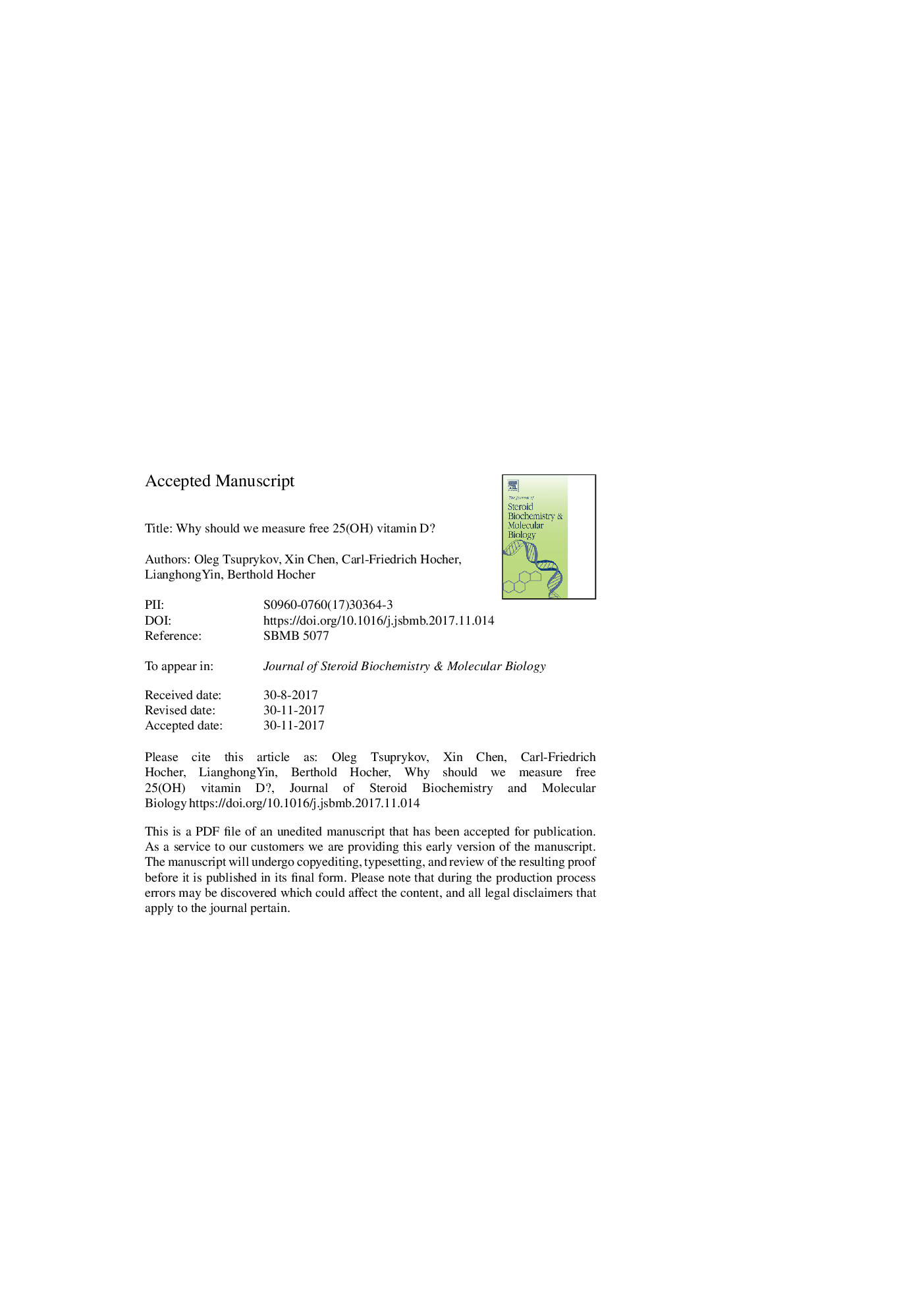| کد مقاله | کد نشریه | سال انتشار | مقاله انگلیسی | نسخه تمام متن |
|---|---|---|---|---|
| 8337805 | 1540967 | 2018 | 52 صفحه PDF | دانلود رایگان |
عنوان انگلیسی مقاله ISI
Why should we measure free 25(OH) vitamin D?
دانلود مقاله + سفارش ترجمه
دانلود مقاله ISI انگلیسی
رایگان برای ایرانیان
کلمات کلیدی
pTHFree vitamin D1,25(OH)2 vitamin DCYP2R11,25 dihydroxyvitamin DFGF-23VDRBMDDBPTNFαIL-6AKI1,25(OH)2D - 1،25 (OH) 2D25(OH)D - 25 (OH) D25-hydroxyvitamin D - 25 هیدروکسی ویتامین Dacute kidney injury - آسیب حاد کلیهinterleukin 6 - اینترلوکین 6chronic kidney disease - بیماری مزمن کلیویBone mineral density - تراکم معدنی استخوانELISA - تست الیزاEnzyme-linked immunosorbent assay - تست الیزاtumor necrosis factor alpha - تومور نکروز عامل آلفاfibroblast growth factor 23 - فاکتور رشد فیبروبلاست 23LDL - لیپوپروتئین کم چگالی(کلسترول بد)CKD - نارسایی مزمن کلیهparathyroid hormone - هورمون پاراتیروئیدVitamin D-binding protein - پروتئین اتصال دهنده ویتامین DGenetic polymorphism - پلیمورفیسم ژنتیکیLow-density lipoprotein cholesterol - کلسترول لیپوپروتئین با چگالی کمVitamin D receptor - گیرنده ویتامین D
موضوعات مرتبط
علوم زیستی و بیوفناوری
بیوشیمی، ژنتیک و زیست شناسی مولکولی
زیست شیمی
پیش نمایش صفحه اول مقاله

چکیده انگلیسی
Vitamin D, either in its D2 or D3 form, is essential for normal human development during intrauterine life, kidney function and bone health. Vitamin D deficiency has also been linked to cancer development and some autoimmune diseases. Given this huge impact of vitamin D on human health, it is important for daily clinical practice and clinical research to have reliable tools to judge on the vitamin D status. The major circulating form of vitamin D is 25-hydroxyvitamin D (25(OH)D), although it is not the most active metabolite, the concentrations of total 25-hydroxyvitamin D in the serum are currently routinely used in clinical practice to assess vitamin D status. In the circulation, vitamin D - like other steroid hormones - is bound tightly to a special carrier - vitamin D-binding protein (DBP). Smaller amounts are bound to blood proteins - albumin and lipoproteins. Only very tiny amounts of the total vitamin D are free and potentially biologically active. Currently used vitamin D assays do not distinguish between the three forms of vitamin D - DBP-bound vitamin D, albumin-bound vitamin D and free, biologically active vitamin D. Diseases or conditions that affect the synthesis of DBP or albumin thus have a huge impact on the amount of circulating total vitamin D. DBP and albumin are synthesized in the liver, hence all patients with an impairment of liver function have alterations in their total vitamin D blood concentrations, while free vitamin D levels remain mostly constant. Sex steroids, in particular estrogens, stimulate the synthesis of DBP. This explains why total vitamin D concentrations are higher during pregnancy as compared to non-pregnant women, while the concentrations of free vitamin D remain similar in both groups of women. The vitamin D-DBP as well as vitamin D-albumin complexes are filtered through the glomeruli and re-uptaken by megalin in the proximal tubule. Therefore, all acute and chronic kidney diseases that are characterized by a tubular damage, are associated with a loss of vitamin D-DBP complexes in the urine. Finally, the gene encoding DBP protein is highly polymorphic in different human racial groups. In the current review, we will discuss how liver function, estrogens, kidney function and the genetic background might influence total circulating vitamin D levels and will discuss what vitamin D metabolite is more appropriate to measure under these conditions: free vitamin D or total vitamin D.
ناشر
Database: Elsevier - ScienceDirect (ساینس دایرکت)
Journal: The Journal of Steroid Biochemistry and Molecular Biology - Volume 180, June 2018, Pages 87-104
Journal: The Journal of Steroid Biochemistry and Molecular Biology - Volume 180, June 2018, Pages 87-104
نویسندگان
Oleg Tsuprykov, Xin Chen, Carl-Friedrich Hocher, Roman Skoblo, Lianghong Yin Lianghong Yin, Berthold Hocher,